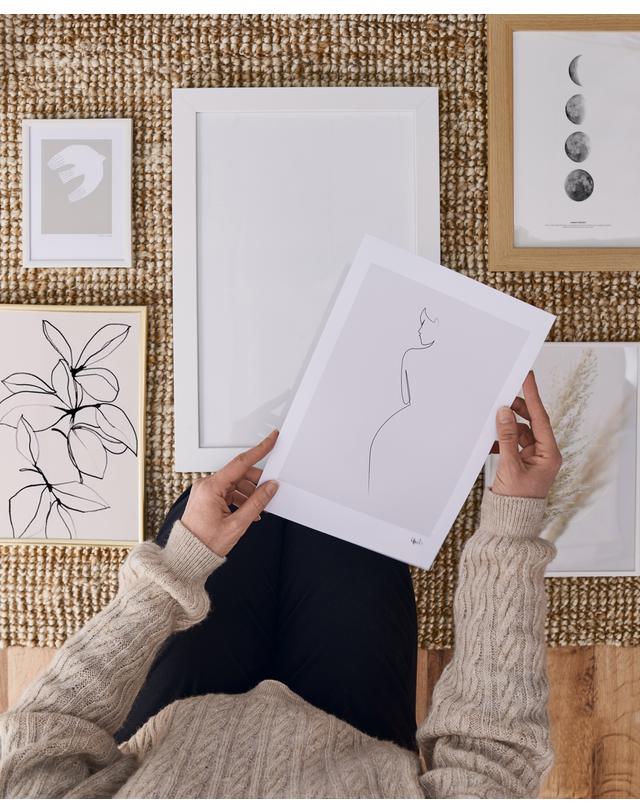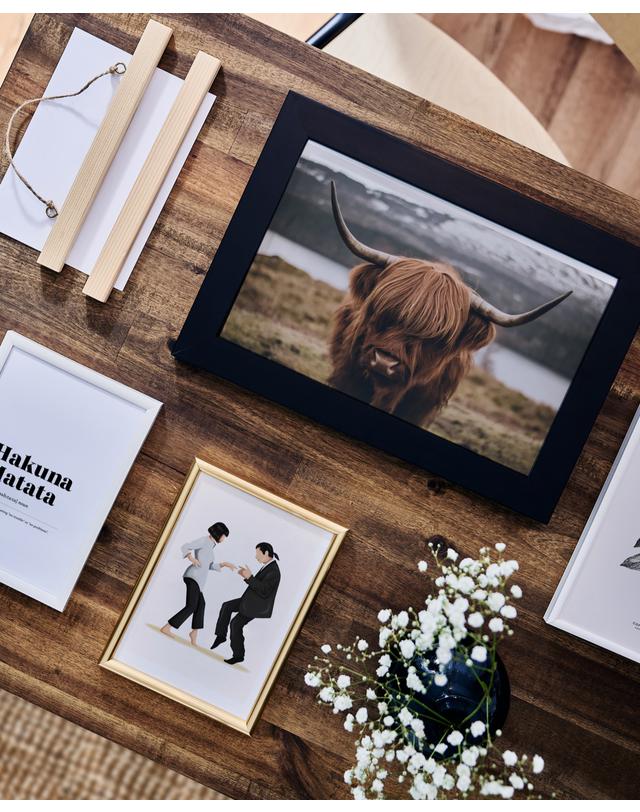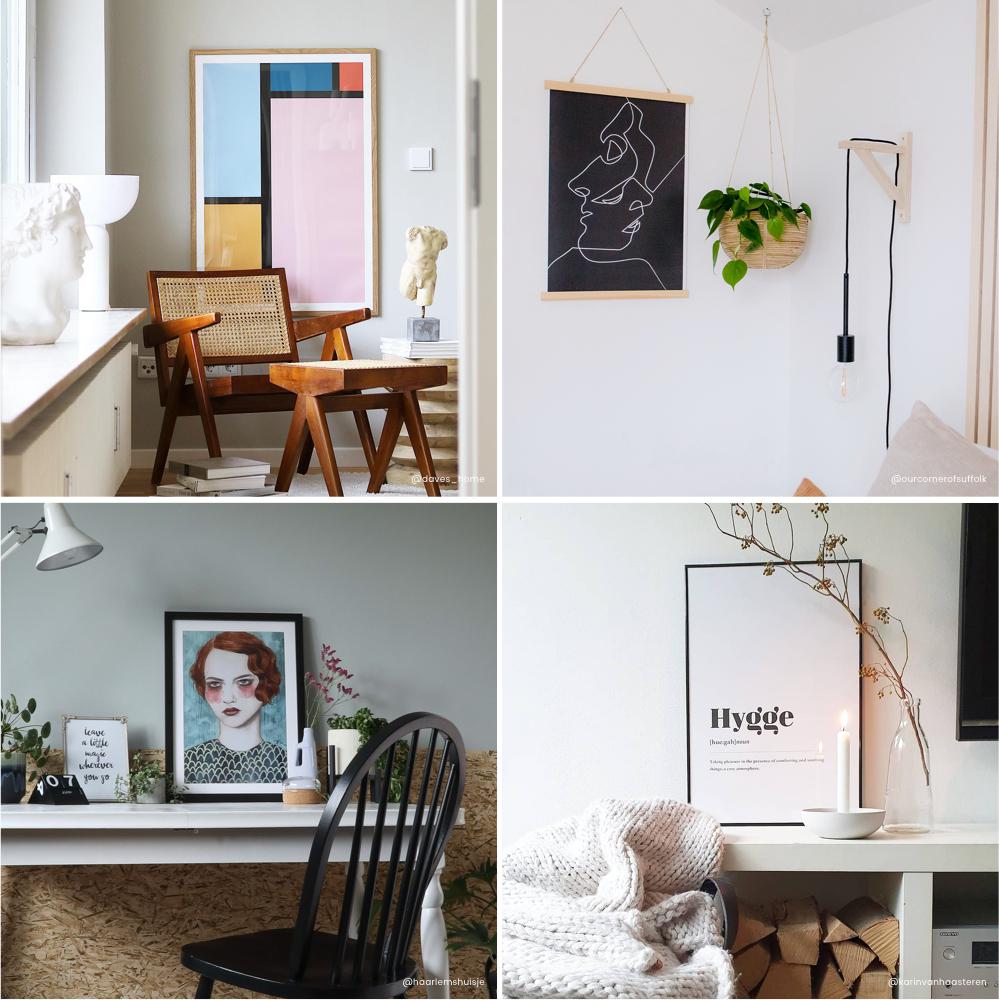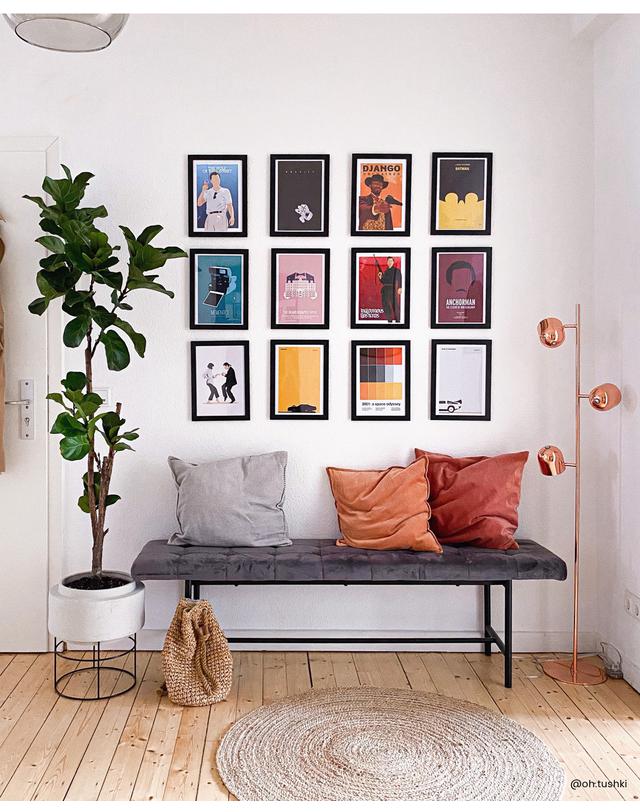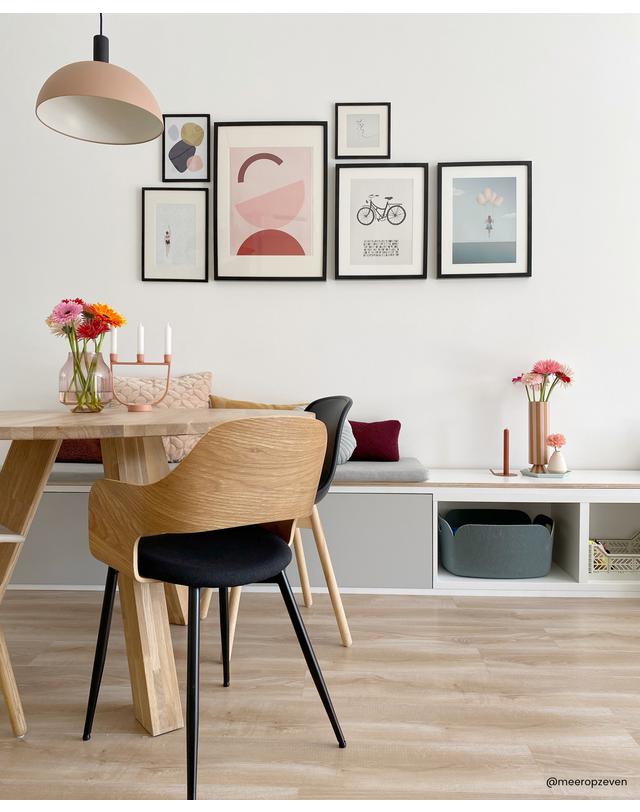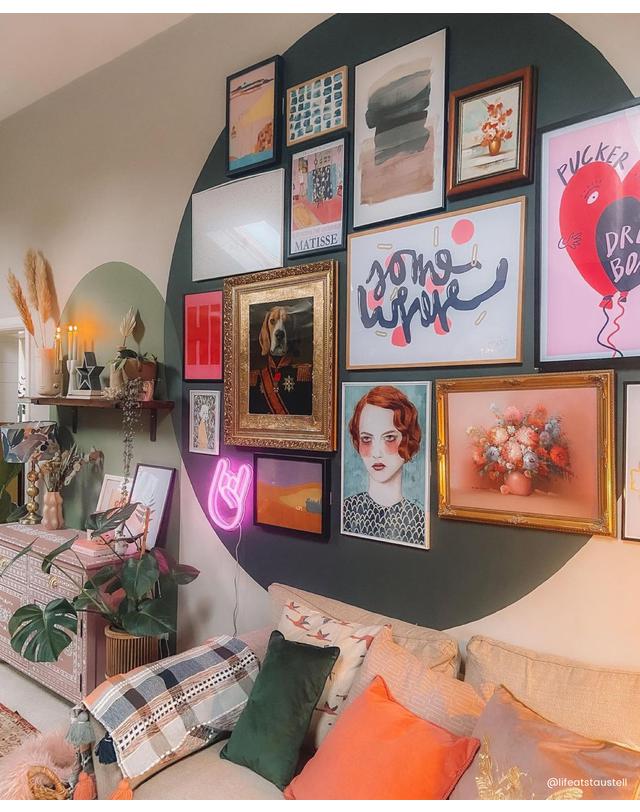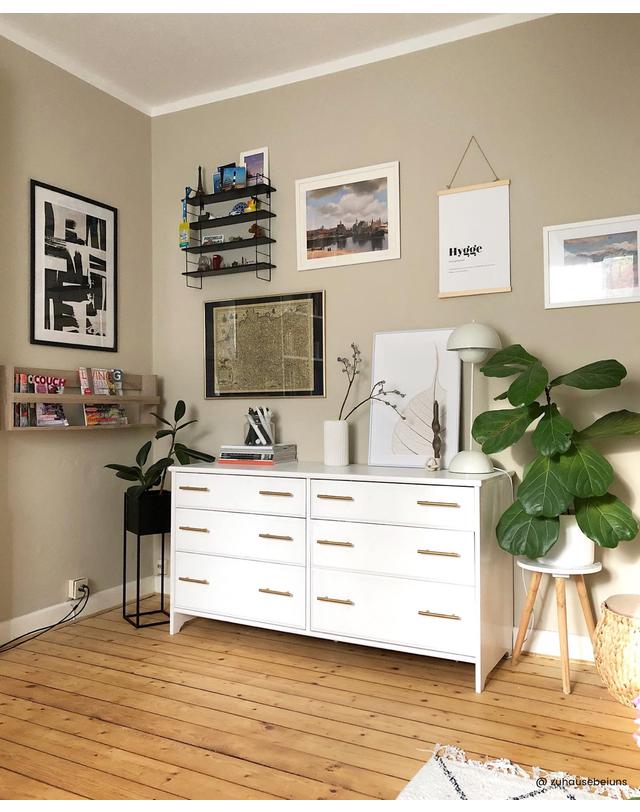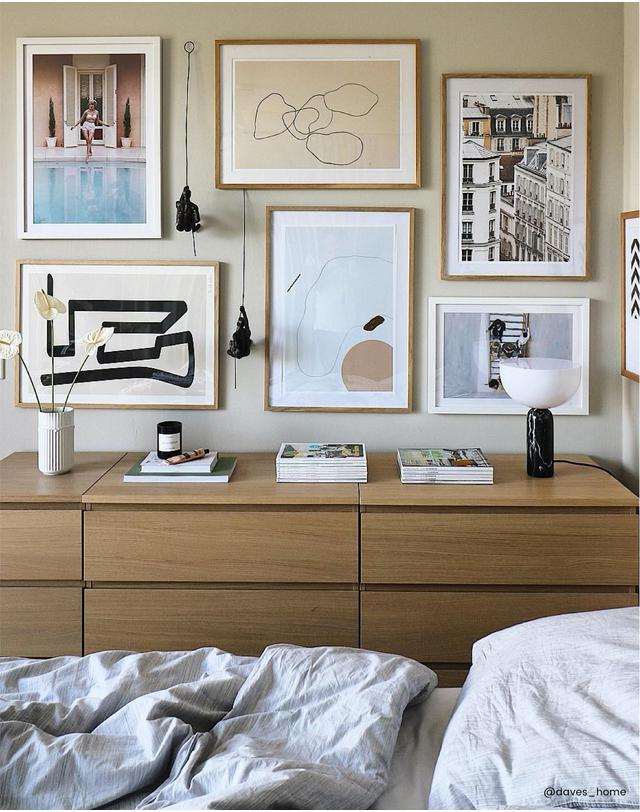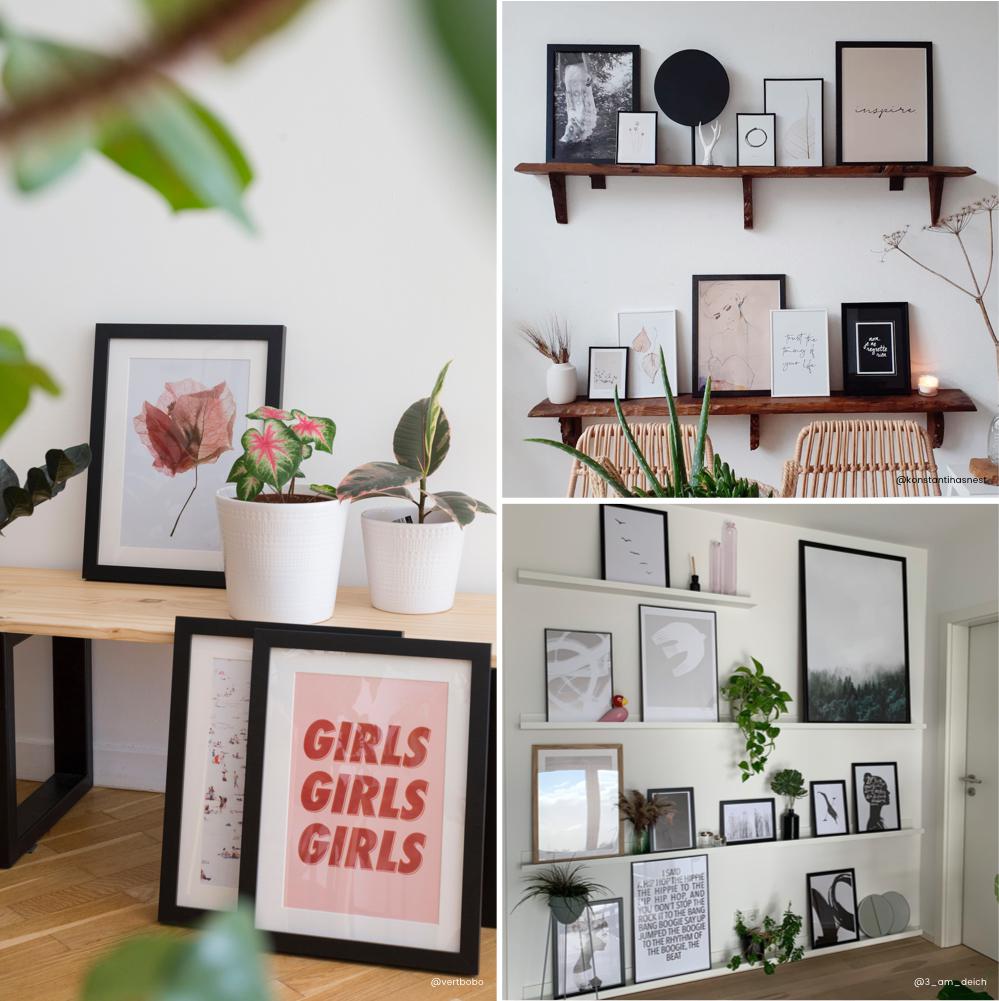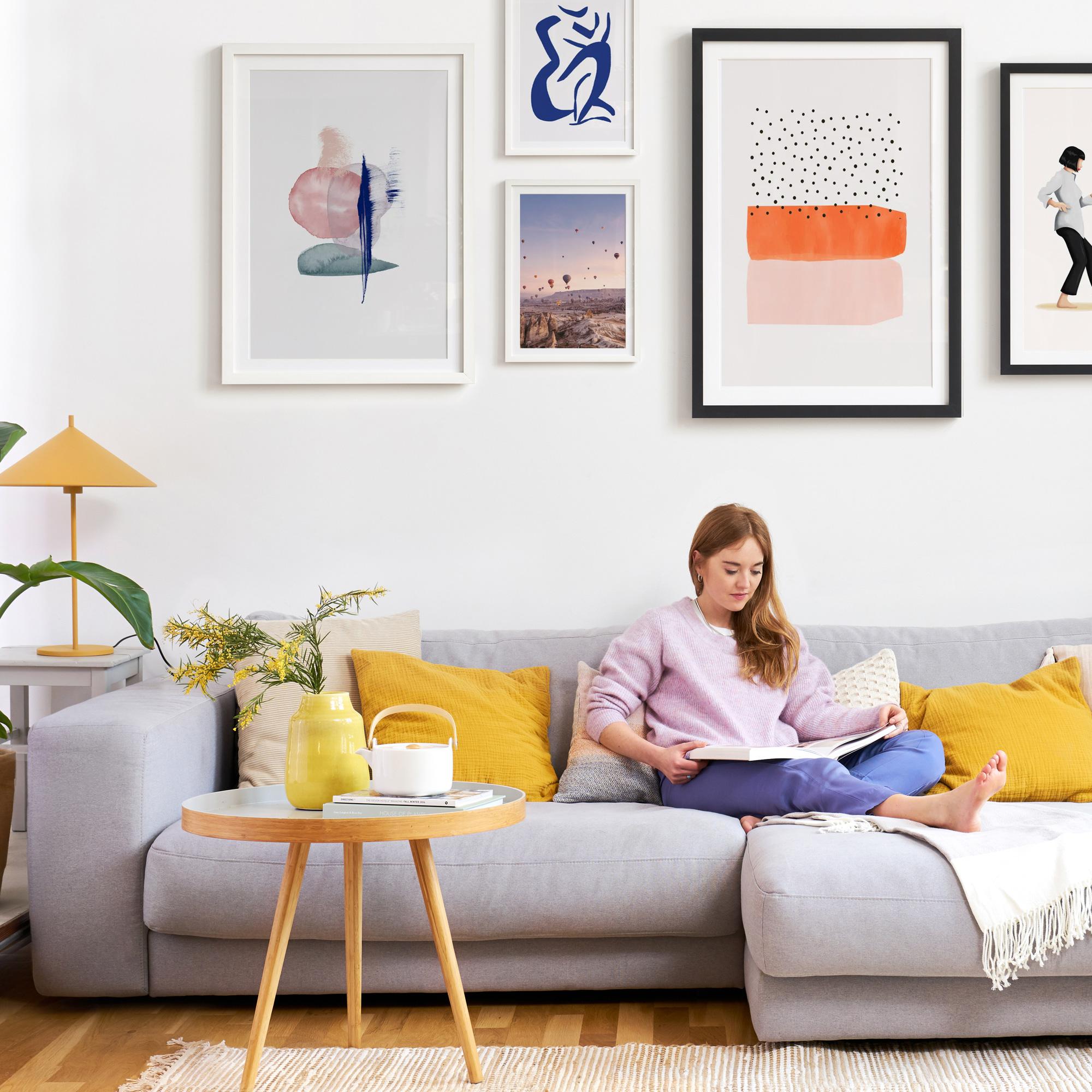Tips before you start
1. Brainstorm
Before you begin hanging your wall art, there are some key questions to consider. How can you arrange your pictures to make the most of the space? What effect do you want to achieve with your gallery wall? And just how high should frames be hung? Interior experts say that 1.6 metres is the golden rule—but ultimately it depends on your taste and the space you’re working with. Find more precise recommendations on height here. But first, close your eyes and take a moment to imagine your perfect layout.
2. Trial and error
Tempting though it may be, don’t rush to the hammer straight away. Lay out all your pictures on the floor and experiment with a few different gallery wall layouts before you commit to a final arrangement. Once you’re feeling confident, enlist some friends to hold the pictures against the wall to see how it works in practice. Looks good? Take a pencil and mark the exact point you’ll be drilling as a guide.
3. Play it safe
Always be careful when drilling—from electrical cables to pipes, you never know what could be lurking behind your walls. If you have any big concerns, try using a wire detector or digging out the blueprints, if you're lucky enough to have them. Oh, and make sure you always turn off the electricity in the room before drilling! If you’re worried about damaging your walls or want a less permanent solution, take a look at this guide on how to hang wall art without nails.
Choosing your frames
From elegant wooden frames to simpler frames, there are plenty of affordable yet stylish options when it comes to giving your prints the attention they deserve. For an eclectic, bohemian look, mix different colours and materials—think vintage gold with white wooden frames. If you’re planning a simple, classic gallery wall, black wooden frames with a passe-partout will create consistency and give your prints an authentic, gallery-ready appearance.
Before you start to bring your gallery wall together, particularly if you’re going for a mix-and-match feel, consider which frames work best alongside each other to create a flowing, cohesive aesthetic. Avoid hanging too many of the same frame types together if you’re working with multiple styles.
Tip: You can make smaller prints pop with chunkier frames, and maintain the balance between prints of varying sizes by choosing subtle, slim frames for larger posters.
Selecting the perfect gallery wall layout for you
There are a few different arrangements you can choose when it comes to creating a gallery wall—you just need to decide which one best showcases your own personal style.
1. The Traditionalist
You like your decoration simple and classic, and you want an interior that conveys order and clarity. Why not try hanging your wall art in a grid or row arrangement?
2. The Bohemian
You’re not afraid to make a statement. You want to be original and have chosen a medley of different sizes or colours to adorn your own personal gallery wall. Go for a loose grid layout or patchwork of frames.
3. The Eclecticist
You value creativity over order and have never been one to play by the rules. Throw caution to the wind and get creative with a salon-style arrangement.
How to hang pictures in a grid arrangement
Create a sense of harmony in your room by hanging your wall art in a uniform grid arrangement. This is a great solution if you have several artworks of similar size.
Our advice
• Think of your prints as a collective whole. The grid arrangement is all about the overall impact!
• Leave a gap of 4–5 cm between each design. The larger the works, the more space you can leave.
Pro tip: • This gallery wall layout works best with prints that share a common colour scheme or theme.
The row arrangement
If you’re working with prints of different sizes, align them horizontally in a row for a playful but considered gallery wall arrangement.
Our advice
• Depending on the placement of your furniture and the size of the room, you can choose to line up the top, middle or bottom of the posters—whatever floats your boat!
Pro tip: Why not tell a story with your prints? By combining typographic artworks, colourful illustrations and abstract designs, you can take your dinner guests on an artistic adventure.
Salon hanging
Ever heard of the Hermitage Museum in St. Petersburg? It’s chock-a-block with paintings, and their arrangement is simply beautiful. Follow their cue and try hanging lots of prints close together, showing off the breadth of your collection.
Our advice
• Traditional aesthetic conventions can be thrown out the window—just go with your gut. At the end of the day, you’re the one who’ll have to look at this wall every day.
• Begin in the middle and work outwards. If you start with what you have, you can add to your collection over time without having to redesign your gallery wall.
Pro tip: Define the borders of your gallery wall with tape.. Make sure your tape lines are straight by using a spirit level. If you don’t have one at home, you can download a level app on your phone. That way, you can easily check to see if your frames are straight by comparing them with the tape lines.
Loose grid
Are you a fan of organised chaos? Then the column layout is the one for you! Working perfectly with prints of various sizes, the main aim is to find a vertical line.
Our advice
• One method is to place your works on either side of an imaginary line, playing with both unity and disorder.
• Alternatively, try placing one row of same-sized prints between two rows of a different size to create a mirror effect. Or why not use columns?
Pro tip: Bring a neglected corner of your room to life with a loose grid arrangement that straddles two walls. It’s an easy way to make a small space more dynamic—without it looking cluttered.
A patchwork of frames
Sometimes it’s best to think outside the frame—so why not create a patchwork of art on your wall! The closeness of the frames and the unity of the works is what distinguishes this arrangement from a salon-style gallery wall. A collage layout is particularly effective if your frames are of similar colours.
Our advice
• Bring together works that have something in common, for example the same colour palette, style or theme.
• Hang your prints close together, so that they’re almost touching. The less space between them, the more successful the illusion of a single large image will be.
Pro tip: Not sure how to hang your pictures in a patchwork layout without it looking too busy? Simple: place your bigger works to the right to create a better visual balance.
How to hang pictures without nails
Lean your prints against the wall
Create a laid-back and effortless look in next to no time by casually propping up your prints loft-style. Different sized frames displayed together will create a layered appearance that draws the eye to the lower part of the wall. If your room has high ceilings (lucky you!), lean your prints against the lower third of your wall, beneath shelves or next to taller furniture, to add some colour at eye level and make your room feel more complete.
Hang wall art with adhesive tape
Did you know that 4 adhesive strips can hold up to 2kg of weight? So they’re an option even for larger, heavier prints. Hanging your wall art with adhesive tape allows you to create any of the gallery wall layouts mentioned above, with zero risk of damaging your walls. They’re also easy to remove should you change your mind about the positioning of your prints, or when you just feel like replacing them and trying something new.
Bench your prints
Designate some space for your prints to break up the flow of books and boxes, or go all out with a shelf dedicated solely to displaying your favourite prints. If the thought of putting up a shelf makes you want to click the little x in the top left corner of the screen, don’t fret. A bench works just as well in making your prints a focal point, without the need to hang your pictures. Add extra details, such as books and plants, for a personal finishing touch.
What’s the best height to hang your pictures?
Regardless of which layout you decide to go for, always try to keep the centre of each work at about eye level. This can vary depending on the size of the frames and on your walls, but a general rule of thumb is 1.6 metres (63 inches) from the ground.
If you hang several works in a grid, then treat them all as a set—their common centre should then be about 1.6 metres high.
However, this can differ from home to home. Take furniture and other objects into consideration—a window or door can also help you find the right height for your pictures. You can then fine-tune your arrangement accordingly.
And there you have it,, you’ve mastered the art of displaying your prints! We hope that hanging your pictures and creating your ideal gallery wall layout now seems like less of a challenge, and more of a fun opportunity to get creative and showcase your style. We’re curious to know how you get on, so share the results with us via @juniqeartshop. Or, if you’re feeling inspired to add to your collection, explore inspiring, affordable designs to complete your beautiful new gallery wall.

